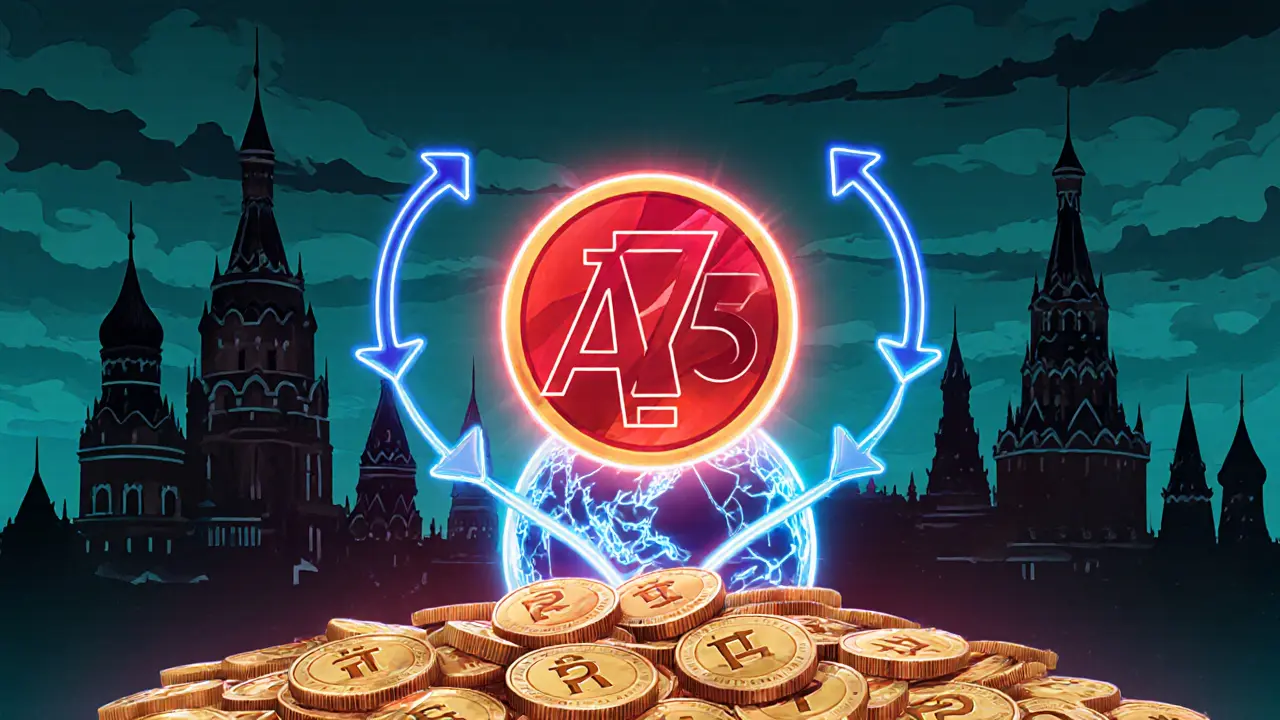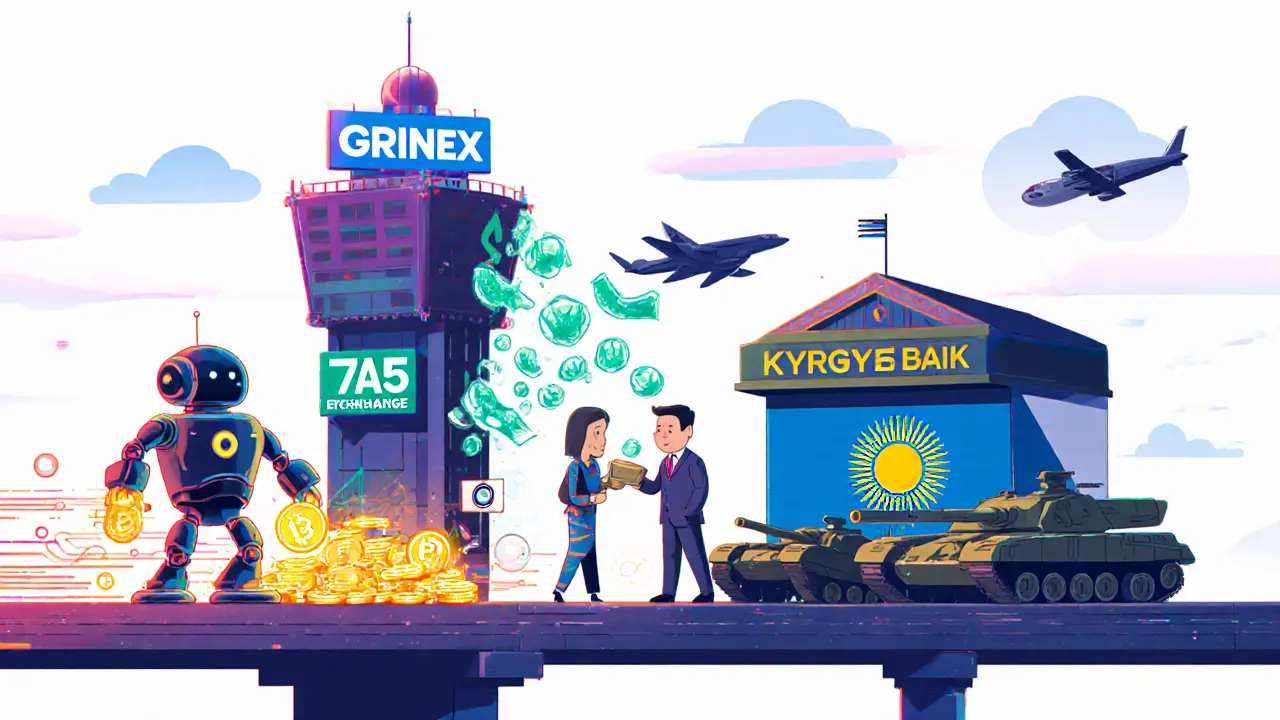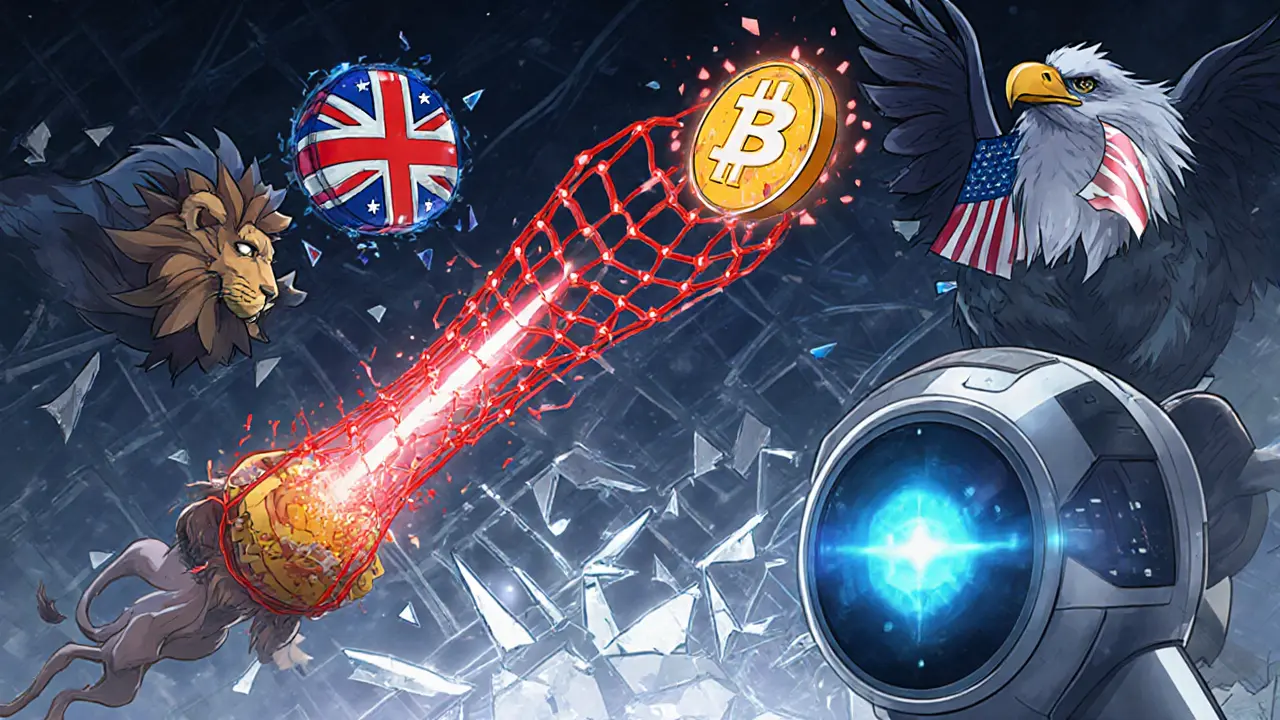
Russia's Crypto Sanctions Bypass Tracker
A7A5 Token
Ruble-backed cryptocurrency
Grinex Exchange
Post-sanctions successor
Capital Bank
Offshore fiat bridge
How the Network Works
- Ruble Conversion: Russian entities deposit rubles into A7A5 smart contract
- Exchange Routing: Tokens traded on Grinex/Meer for stablecoins
- Stablecoin Laundering: Over $8B in stablecoin transactions
- Bank Integration: Capital Bank converts stablecoins to fiat
- Final Spend: Funds used for military procurement
Comparison: Garantex vs Grinex
| Feature | Garantex | Grinex |
|---|---|---|
| Year Founded | 2019 | 2025 |
| Blockchain Support | Ethereum, BSC | Ethereum, TRON |
| Sanctions Status | US OFAC-designated | US & UK-designated |
| A7A5 Volume (4-month) | $1.2B | $9.3B |
| Public Messaging | Standard marketing | "Sanctions-free" positioning |
Regulatory Response
Western regulators have taken coordinated action:
- UK: Added Grinex, Meer, and A7A5 to sanctions list
- US: OFAC designated token and exchanges as SDNs
- EU: Banned transactions on platforms facilitating "Russian crypto laundering"
- FATF: Warned about virtual assets in illicit financing
Western countries have piled on financial sanctions since Russia’s invasion of Ukraine, but the Kremlin has found a new back‑door: cryptocurrency. By marrying state‑backed tokens, offshore exchanges and a handful of cooperative banks, Moscow can move billions of dollars around the globe while staying out of the traditional banking radar. This article untangles the most important pieces of that network, shows how the flow works step by step, and explains what regulators are doing to close the loopholes.
Key Takeaways
- The A7A5 token, a ruble‑backed crypto asset, has processed over $9billion in just four months.
- Garantex was shut down in March2025; its operators instantly launched Grinex to keep the money moving.
- Kyrgyzstan‑based Capital Bank links the crypto world to fiat for buying military equipment.
- Western regulators have begun targeting the whole chain - from tokens to exchanges - in coordinated sanctions packages.
- Compliance firms are now adding A7A5 to their screening tools, signalling a new era of crypto‑focused enforcement.
The Sanctions Landscape
Since early 2022, the United States, the United Kingdom, the European Union and dozens of allied nations have imposed more than 2700 sanctions on Russian individuals, companies and financial institutions. The goal is simple: choke off the flow of money that fuels the war effort. Yet sanctions primarily target traditional banking channels, leaving digital assets relatively untouched - at least until 2025.
Western sanctions are legal measures that prohibit financial institutions and citizens of sanctioning countries from dealing with designated Russian entities. They rely on correspondent banking relationships, which can be blocked or frozen by regulators. When those routes close, actors look for alternatives that lie outside the conventional system.
The European Union’s 19th sanctions package, announced in June2025, was the first to explicitly name “dirty crypto schemes” and ban transactions on platforms that facilitate sanctioned Russian flows. The United Kingdom followed suit in October2025, naming the Grinex exchange and the A7A5 token as high‑risk assets. Meanwhile, the United States’ Office of Foreign Assets Control (OFAC) has designated both the token and its supporting exchanges as specially sanctioned entities.
The Crypto Infrastructure Behind the Bypass
At the heart of the operation sits a purpose‑built digital asset: the A7A5 token is a ruble‑backed cryptocurrency issued on both the TRON and Ethereum blockchains, designed to convert Russian roubles into a tradable digital form. In four months since its launch, the token moved $9.3billion through a dedicated exchange, effectively turning sanctioned rubles into a globally spendable asset.
The exchange ecosystem consists of three key platforms:
- Garantex is a Russian‑linked crypto exchange that was sanctioned by the United States in early 2025.
- After law‑enforcement raids in March2025, Garantex’s staff spun up Grinex is a successor exchange promoted as a “sanctions‑free” alternative, quickly becoming the primary hub for A7A5 trades.
- A third platform, Meer is an offshore exchange that mirrors Grinex’s services and was also flagged by OFAC in late 2025.
Connecting the digital world to cash is Capital Bank is a Kyrgyzstan‑based financial institution that bridges crypto wallets with fiat accounts, allowing conversion of digital assets into dollars, euros or rubles for procurement. Its director, Kantemir Chalbayev is a Kyrgyz businessman who oversees the bank’s role in funding Russian military purchases.
How the Network Moves Money - Step by Step
- Ruble conversion: Russian state‑controlled entities deposit roubles into the A7A5 token’s smart contract, minting an equivalent amount of digital tokens on TRON and Ethereum.
- Exchange routing: The newly minted tokens are transferred to Grinex (or Meer) where they are paired with stablecoins such as USDT and USDC.
- Stablecoin laundering: Large wallets, many linked to the A7A5 ecosystem, receive over $8billion in stablecoin inflows over the past 18months, according to Elliptic’s leaked data.
- Bank integration: Capital Bank receives the stablecoins, converts them to fiat via domestic partners, and credits Russian defense contractors or overseas suppliers.
- Final spend: The fiat cash is used to purchase weapons, ammunition, logistics services, or to fund political operatives in neighboring states such as Moldova.
Each layer adds a level of obfuscation, making it hard for regulators to trace the ultimate beneficiary. The ability to shift between two blockchains (TRON’s low fees and Ethereum’s broad ecosystem) also ensures the network can survive a shutdown on any single chain.

Scale, Reach, and Real‑World Impact
Data released on September32025 showed that wallets tied to the A7A5 token and its affiliated exchanges received $8billion in stablecoin transactions in just 18months. Those funds have financed everything from battlefield equipment to a suite of apps that pay and track political activists in Moldova, as revealed by the IlanShor leaks.
In addition, the token’s own on‑chain metrics indicate $9.3billion in volume over a four‑month window, a figure that dwarfs most regional crypto projects. The rapid accumulation of value demonstrates both the demand for a sanction‑resistant vehicle and the effectiveness of the Russian‑backed design.
International Regulatory Counter‑Measures
Regulators have responded with a coordinated push to choke the network at every point:
- The United Kingdom’s October2025 sanctions list explicitly named Grinex, Meer, and the A7A5 token, freezing any UK‑based assets linked to them.
- The United States’ OFAC added the same entities to its Specially Designated Nationals (SDN) list, prohibiting any US person from dealing with them.
- The European Union’s 19th package banned transactions on any platform identified as facilitating “Russian crypto laundering”.
- The Financial Action Task Force (FATF), in a briefing to the UN Security Council on August202025, warned that virtual assets are increasingly being used for illicit financing, urging member states to adopt stricter AML/CFT standards for crypto.
These moves aim to shrink the network’s liquidity pools, make it harder for Russian actors to cash out, and increase the legal risk for any third‑party service that assists.
Industry Adaptation - Compliance Gets Smarter
Crypto compliance firms have begun updating their screening tools. Elliptic is a blockchain analytics company that now flags A7A5 transactions on both TRON and Ethereum networks. By integrating the token into its watchlists, Elliptic helps exchanges, custodians and financial institutions detect and block suspicious flows before they convert to fiat.
Other firms are rolling out “crypto‑sanctions risk scores” that factor in token provenance, exchange reputation, and the presence of shell companies in jurisdictions like Kyrgyzstan. These tools are still evolving, but the market shows a clear shift toward treating digital assets with the same rigor as traditional banking.
Comparison: Garantex vs. Grinex
| Feature | Garantex | Grinex |
|---|---|---|
| Year founded | 2019 | 2025 (post‑sanctions) |
| Primary blockchain support | Ethereum, Binance Smart Chain | Ethereum, TRON (dual‑chain) |
| Sanctions status (Oct2025) | US OFAC‑designated | US OFAC & UK‑designated |
| Volume of A7A5 trades (4‑month period) | ~$1.2billion (pre‑shutdown) | ~$9.3billion (post‑launch) |
| Public messaging | Standard exchange marketing | “Sanctions‑free” positioning, explicit claim of continuity after Garantex freeze |
Future Outlook - Will the Crypto Shortcut Survive?
Analysts at Oxford Analytica warned in September2025 that while Russia’s crypto playbook offers short‑term relief, it also draws increasing scrutiny. As compliance tools improve and more jurisdictions adopt crypto‑specific sanctions, the cost of operating a parallel digital network will rise.
In practice, this means we can expect a new wave of “privacy‑first” tokens, more offshore shell structures, and a shift toward decentralized finance (DeFi) protocols that hide the true counterparties behind smart contracts. At the same time, regulators are learning to trace token flows across multiple chains, meaning the cat‑and‑mouse game will intensify.
For the broader crypto industry, the lesson is clear: ignoring the geopolitical dimension is no longer an option. Exchanges, wallets, and blockchain analytics firms must embed sanctions‑screening into their core processes, or risk being swept up in the next wave of enforcement.

Frequently Asked Questions
What is the A7A5 token?
A7A5 is a custom cryptocurrency created in 2025 that ties its value to the Russian ruble. It runs on both the TRON and Ethereum blockchains, allowing users to swap rubles for a digital asset that can then be traded or converted into stablecoins.
Why did Garantex disappear and how did Grinex appear?
U.S. authorities seized Garantex in March2025, citing sanctions violations. The same team quickly launched Grinex, advertising it as a “sanctions‑free” platform that would inherit Garantex’s user base and liquidity.
How does Capital Bank help Russia’s war effort?
Capital Bank accepts stablecoins from the crypto exchanges, converts them into fiat currencies, and then releases that cash to Russian defense firms. Its director, Kantemir Chalbayev, coordinates the flow to ensure the money reaches arms suppliers.
What actions have Western regulators taken against these crypto schemes?
The UK, EU and US have all added the token, Grinex and related entities to their sanctions lists, banned transactions on identified platforms, and urged AML/CFT regulators to treat digital assets like traditional banks.
Can crypto compliance tools now detect A7A5?
Yes. Companies such as Elliptic have updated their screening databases to flag A7A5 on both TRON and Ethereum, helping exchanges and custodians block suspicious transfers.


Comments
Santosh harnaval
This is wild. Russia turning crypto into a war chest. Not surprised, but still chilling to see how fast it scaled.
Claymore girl Claymoreanime
Let’s be honest-this is what happens when you let decentralized finance exist without a global sovereign authority. The West’s entire financial architecture is built on centralized control, and now it’s crumbling because we refused to regulate crypto like the systemic risk it is. This isn’t innovation-it’s institutional failure dressed in blockchain.
Will Atkinson
I really appreciate how thorough this breakdown is. It’s easy to dismiss crypto as just speculative noise, but when you see the actual mechanics-TRON for speed, Ethereum for reach, Capital Bank as the bridge-it becomes clear this is a carefully engineered workaround. Honestly? It’s kind of brilliant, even if it’s morally bankrupt. We need better tools, not just more sanctions.
monica thomas
The systematic circumvention of international financial norms through tokenized state-backed assets represents a profound challenge to the post-Bretton Woods order. One must consider the implications for global monetary sovereignty and the erosion of intergovernmental cooperation.
Edwin Davis
So the U.S. and Europe spent billions on sanctions and Russia just made its own currency? Pathetic. We’re letting them laugh at us while we argue about compliance forms. Time to stop talking and start blowing up their servers.
emma bullivant
i think the real story here is how fast the crypto world adapts-garantex to grinex? thats not a reboot, thats evolution. we’re not fighting hackers, we’re fighting ghosts. and the ghosts keep changing their names.
Michael Hagerman
I just watched a documentary about this last night. The part where they moved $9 billion in four months? That’s not a loophole. That’s a goddamn highway. And now they’re building toll booths on it. I’m not mad. I’m impressed.
Laura Herrelop
You think this is about sanctions? Think deeper. This is a test run for a new global financial system-one that doesn’t need the U.S. dollar, doesn’t need SWIFT, doesn’t need you. The A7A5 token is the first bullet in a quiet revolution. The banks are already scared. They just won’t admit it.
Nisha Sharmal
Western sanctions are a joke. You think cutting off banks stops a country with 140 million people? We’ve been doing this for centuries. Crypto? Just another tool. Like the wheel. Or fire. You can’t un-invent technology.
Karla Alcantara
It’s sad, really. People are suffering because of this, but I also see how innovation finds a way-even when it’s used for bad things. Maybe the answer isn’t more bans, but better ways to track without crushing privacy. We need smarter solutions, not just louder outrage.
Jessica Smith
This isn’t crypto. It’s laundering with a tech bro accent. And now you’re all acting like it’s some kind of genius hack? No. It’s crime with a whitepaper. The only thing worse than the operation is how many people are pretending it’s not evil.
Petrina Baldwin
Capital Bank is the real key. No one talks about that.
Ralph Nicolay
The regulatory response has been both timely and insufficient. While the designation of A7A5 and its associated entities under OFAC and UK sanctions represents a necessary escalation, the absence of multilateral enforcement mechanisms-particularly concerning jurisdictions like Kyrgyzstan-undermines the efficacy of these measures.
sundar M
Man, this whole thing is like watching a heist movie where the robbers are smarter than the cops. But here’s the thing-I’m from India, and we’ve been dealing with shadow economies for decades. What’s happening here? It’s not new. It’s just digital. The real question isn’t how they’re moving money-it’s why we’re still surprised when people find ways around broken systems. We need to fix the system, not just chase the shadows.